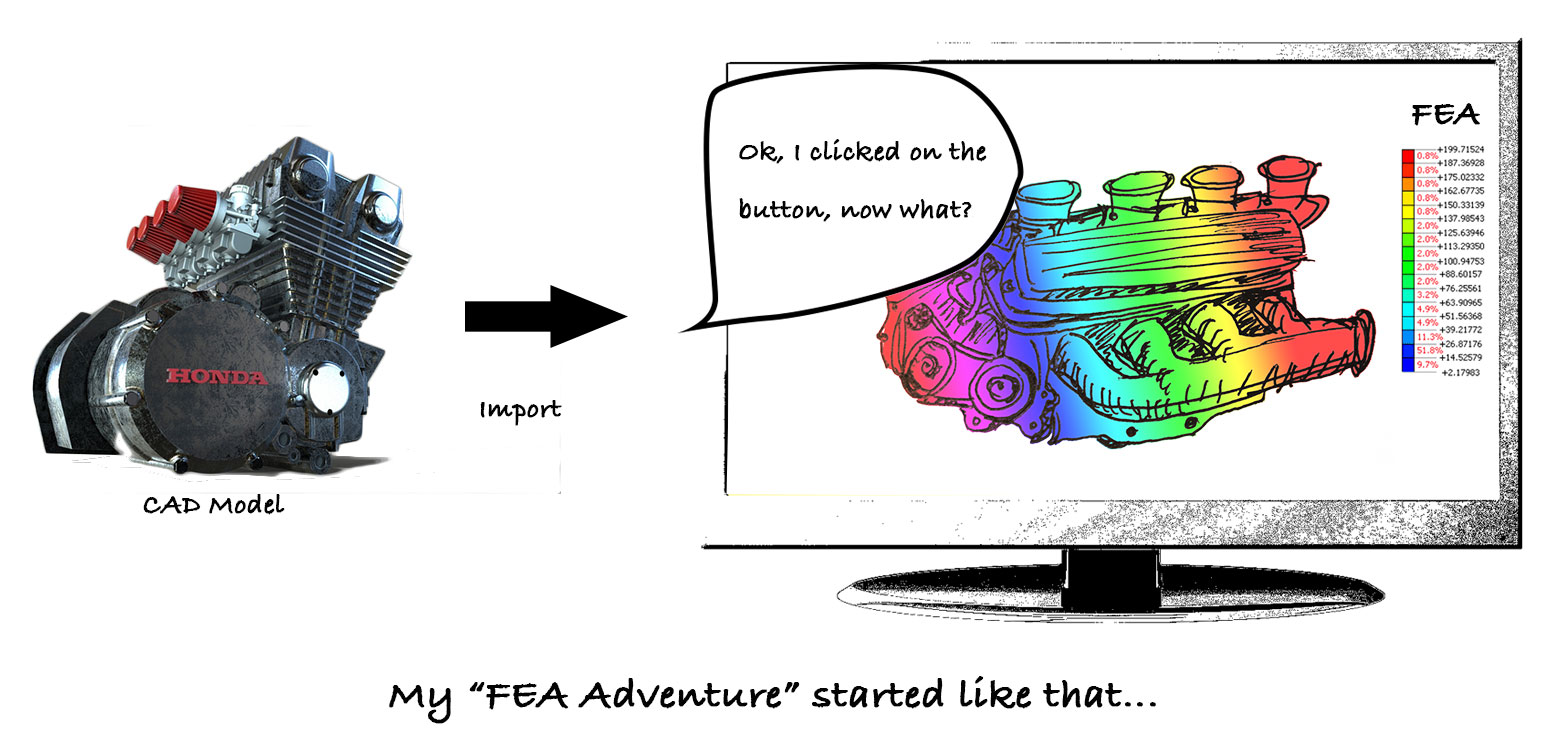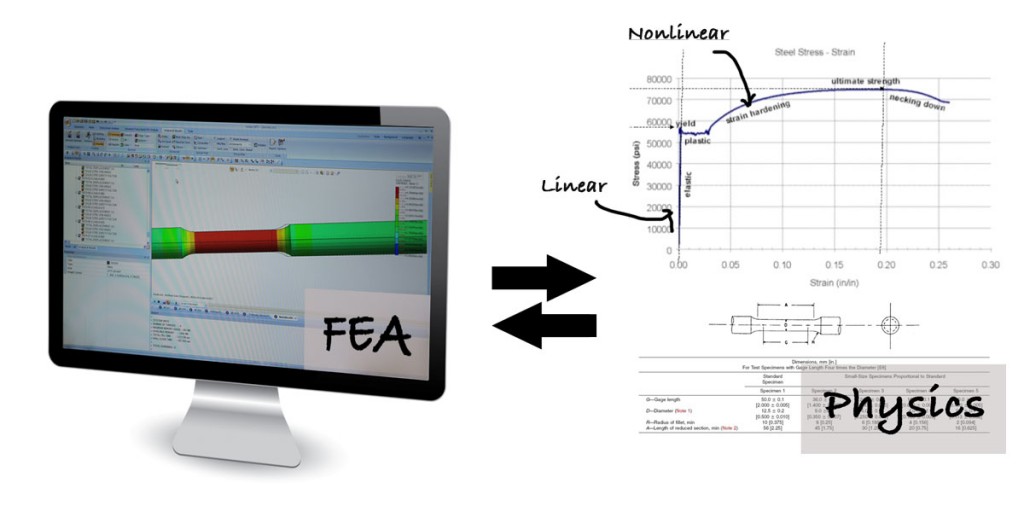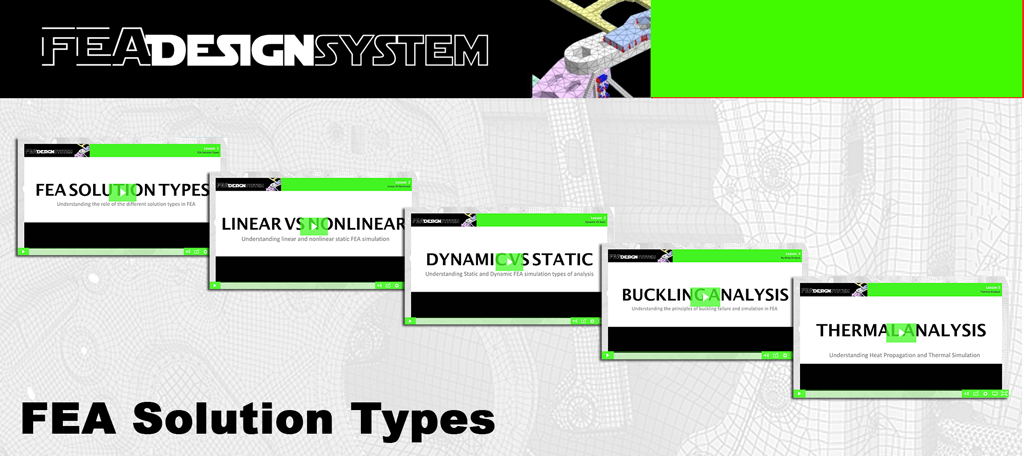When I started my career in FEA Analysis, I had only been trained about the theory and I knew not much about how to simulate a real model.
…And there is this funny story that I remember about the first analysis I did
Let me tell you how I went from “Stress Color Painting” to Real Engineering:

I wanted to simulate a motorcycle wheel to show my boss that I was able to solve complex problems and do advanced simulation despite my inexperience.
So, I went on a website where I could get CAD models and I download a CAD model of a motor engine (and then a motor wheel) and I started to model that in the software.
I had a bit some difficulties to mesh the CAD models first, but after simplifying it a bit, I got my first FE Model.
I was so proud that I thought I had made the perfect simulation from the first try and my boss would be totally impressed.
I fixed the bottom of the engine and I applied a static force and then… up to the solver to do the job!
Analysis was way faster than I thought and I immediately obtained gorgeous stress contours.
I showed it to my colleague on the right of my desk and he was so impressed that I thought that I finally made it.
Who needs experience to do FEA, that’s simple!
…or so I thought.
I went to my boss’s desk and showed to him the printout of the stress contours, but to my surprise, his expression turned glacial and he asked me in a way that I will always remember:

“Cyprien, are you an engineer or are you a stress color painter?”
I didn’t understand at first what he meant by that…
I went back to my desk, broken, but also curious…what did my boss told me that?
Did he thought that I wasn’t an engineer?
Then I decided that I had to ask him directly and the day after I went to his office again to ask:
“Boss, I thought about it all night long, but I am still not getting why you asked me if I was an engineer or a painter…”
Then he answered like that:
“Hahaha, sorry, yesterday, I some other urgent concern and I wasn’t able to explain clearly to you my meaning”
“Everything you do as an engineer should be based on the reality and the physics. Because of that you should always think deeply about your assumptions to be sure that your model is good enough to represent real results”
“Now with the actual technology and software, you can get anything with the push of a button, but that’s doesn’t mean that what you get is correct”
“Beautiful things are often misleading and can easily deceive us into believing they are also correct.”
“So every time you get some stress data, you need also to be able to justify how you got those results by applied which kind of boundary conditions and you MUST be able to justify why you did those assumption”
I finally got his meaning, but there was still something unclear to me:
“So what you are saying is that I didn’t define correctly the problem…”
This was a major insight for me…
Whatever you do, if you input garbage inside your FEA software, you will only get some more garbage out of it!
Results that only looks beautiful but have no physical meaning are useless!

Now that I understood that FEA simulation is all about understanding first how the physics work, I always ask me this question…
Why most people just don’t invest more time and efforts learning the right way what they should know to design and simulate awesome innovative engineering products instead of just searching free tips every day on the web?
I know one designer who ended up doing product design a bit by chance (or maybe just because he graduated from a certain major and had no other choices after college, i don’t remember)
What marked me about him is that he never invested on books and courses to teach him how to really do things.
Instead, he was trying everyday to solve every small problem with google search or free tips found over the internet.
He had absolutely no method or system in place and every time a manager asked him a question, he had the same eternal answer:
« Please let me come back to you tomorrow, I have to check to be sure »
Then, he was spending days and nights to figure out answers to the exact same problems that came back every week.
He was tired and stressed every day and I was always wondering when he would finally give up to do something else.
What was wrong with him?
- When you are an engineer, never try to re-invent the wheel. It is tempting to try to go from zero every time and say at the end that you did EVERYTHING…but that’s just a silly behaviour
- If you want to become a real engineer, you have to invest in a long apprenticeship.
- You have to understand the foundations that exist already very well and you have to « get » them at an intuitive level before you can go to something more complex.
Fortunately, many engineers have come before you and a lot of very effective systems and processes exists to solve almost any kind of problem!
So…
Would you rather like to do the same simple stuffs over and over every day knowing that you did everything by yourself?
…Or would you rather learn how to tap into the knowledge of other FEA engineers that did all the hard work for you upfront to make all the basics you have to know so easy to process that you will directly step from being a beginner to a « strong foundations » engineer and then to an advanced FEA analyst?
The truth is that it is not so difficult to do.
The common myth propagated by those who want you to use their « easy FEA software » is that FEA is « much too complex for you to really become advanced at it in a reasonably short amount of time ».
Well… that’s a lie.
Those people would in fact prefer that you actually stay to the beginner level and never quite get the advance stuffs so they can endlessly supply you with « expert support » and all kind of features supposed to make your life more easy when you don’t understand anything.
Don’t believe them. There is a better way.
The better way is the path of learning.
If you you are already in a position to design products that influence people everyday’s life, then you know how learning was important for you to get to that position.
The real problem is when we choose to stop learning at some moment of our life… either because we are « busy » fighting everyday’s challenges or just because we fell into the trap to believe that learning stops after we graduate from school.
Then we encounter something that need to go back on the path of learning… and we start to hesitate.
The 3 major hidden scripts that prevent us to learning new engineering knowledge
There are those questions we ask ourselves every time we have to get into something new and challenging… those questions may be the hidden cause explaining why you didn’t start to learn already what could have benefited you for YEARS.
Here’s how I answer those questions:
Should I really learn this knowledge?
I had a friend in college who was always telling me how the « high level » math we were learning in class would be useless to anyone in the future… at that time, I wanted to tell him he was wrong, but I didn’t know myself how engineers have been using maths and equations to create innovative products, change the life of people and make a better world…Now I know because I decided to choose the path of learning.
What do you thing that friend became? Due to his hatred for maths, he decided to go and do a psychology degree, then he discover few years after that the number of real jobs as a psychologist were so scarce that he had to forget about his dream and choose to do what he could do… and he discovered also that maths and statistics were useful even in psychology… I couldn’t help bursting with joy when he told me that he was wrong few years later when we met again.
There are many things that if we don’t learn now, we will never know the impact it will have on our life in the future. You never know how learning something will help you to get a better job in the future, go to a higher position, become a consultant or develop your own products.
Won’t it take too much of my everyday time?
If you are like me, you probably like to be as efficient as possible with your time in order to get a lot of things done every day. I understand totally.
What I discovered though is that learning doesn’t require to invest a lot of time. It just need to be regular. So when I want to learn something, I set and label a very specific time of my day just to learn stuffs. During this time, I inactivate all the external stimulus that may distract me and I focus only on learning one thing that I really want to learn.
I usually do that in the morning, when I am fresh and ready to absorb new knowledge and when my brain is not yet full of the daily annoyances that tend to accumulate during the day and make us angry and stressed.
…and guess what?
Learning in the morning is an incredible motivator to start the day. I don’t really know why, but that’s an observation I made. When I learn even something that seem insignificant in the morning, it just renew my sense of purpose to achieve more and be more effective all along the day… I have always been amazed by that!
(Now I started to wake up more and more early in the morning to be able to learn more and more stuffs and I can’t stop being excited by having something new to learn every morning when I wake up… try it and you will see that it works)
Can’t I just hire someone else to do this stuff?
There are 2 types of people: Those who defer work because they don’t know how to do it themselves and those who defer work because they want to be more productive on something else they know has to be done by them.
What’s the difference?
Well… the difference is HUGE.
When you defer something because you don’t know how to do it yourself, you are at the mercy of the person who is doing the work for you. If you can find someone trustable, who is a real expert and care to do exactly the way you want for a reasonable price…then it may be okay for you… BUT (hint) most people you will trust to do something won’t be like that. If you know how to do it yourself, at least you can control them and put some limits, but if you don’t, then your only option will be to follow whatever they will give you and accept it at the price they want….
So, even if you don’t do something by yourself, knowing how to do it will give you a huge unfair advantage to boost your productivity and to control the results.
I know that already
This is not a question, but this is also a hidden barrier to learning that was especially painful for me for years.
It’s when you see something you don’t really know but you deceive yourself into believing that you know it because unconsciously, you don’t want to spend the time to learn it… or sometimes because you simply don’t know that you don’t know it.
This state is dangerous because it can totally prevent you from learning new things, making you rely only on old and outdated information from college that we sometimes don’t even recall so well.
It closes yourself to the “possibility” of learning something new and you don’t even know it…
What’s the right way to learn engineering and FEA Simulation then?
I guess that at that point you understood that the right thing to do was to go back on the road of learning when we don’t know something (or when we think we may benefit in the future from some knowledge acquired now)
But what’s the right way to do it? Come back to the university bench and do a Master or a PhD in Mechanics? Hire a consultant to teach us how to do things?
…or simply follow some online course and try to apply that knowledge into our everyday challenges to become better and better every day?
Well… each of those methods have advantages and drawbacks.
People who usually teach FEA either university professors who write about FEA almost for Free or very advanced FEA consultants who do it for a substantial amount of money.
Those 2 types of FEA teachers are both extremely advanced and expert in FEA, but because of that, they also have problems to explain it simply.
You see, when you are already advanced on something, you see all the hundred possibilities to make a mistake and you understand it so clearly that you would like to tell everything in the most detailed way to your students.
The problem is that experts usually spend a lot of time speaking about little tiny details that seem unimportant to you… because it seems important from their point of view, or because simply they would like to give you the most complete amount of knowledge they think that you should have.
The problem with that?
1- Such a lecture is generally mildly boring (to stay polite), filled with details and anecdotes that you don’t really care about and the important « simple » things for you to know at your level are not emphasised enough
2- Everything is generally packed into presentations with a lot of text which generally distracts you from listening and overwhelm you with unimportant details
3- Professors have even an additional problem… they tend to focus first and foremost on the theory and the maths rather than on how to apply practically the knowledge to an engineering project.
My courses aren’t like that…they are the most simple FEA course you will find on the Internet!
If you have read my blog articles, you know how much care I take to explain in an easy way even the most complex stuffs.
That’s my motto in fact « From basics to Advanced »
What I want is really to transmit to you the basics first and help you to create this foundation of FEA knowledge so you can then become a real FEA analyst with extremely strong basics and understanding of how things work.
I streamline the knowledge and transform it to make it the most possibly understandable and then I intertwine it with practical examples and step by step tutorials to help you to apply the knowledge you just learned.
And finally, I transform everything into a system that will help you to understand better mechanics, physics, FEA simulation in a repeatable and enjoyable way.
Who am I, by the way?

My name is Cyprien Rusu, I am a CAE engineer who wants to teach the right bases of FEA Simulation to designers, engineers and everyone aspiring to get it right!
Hundreds of FEA students followed my free FEA webinars on Youtube, read my blog articles on feaforall.com and joined my FEA courses to learn more and improve their understanding of FEA and become better engineers!
The FEA courses I create are the most easy to understand material available on internet!
I have taught FEA seminars to FEA engineers from all over the world…

And now I am taking that experience to you into my first series of online FEA courses!
Introducing FEA Design System 4: FEA Analysis Types

Here’s what you will learn in this course:
- The problem with how we generally learn FEA (Lesson 1-1)
- The main problem with FEA analysis types (Lesson 1-2)
- The different types of FEA analysis and how each type of analysis is used to solve practical engineering problems (Lesson 1-3)
- How an FEA solver works, the different types of FEA solver and their usage (Lesson 1-4)
- The limitations and assumptions of linear static analysis and the 3 factors that affect the most the linearity (Lesson 2-1)
- The 2 factors that influence stiffness and the impact of deformation on stiffness (Lesson 2-2)
- When you can consider a material is within the linear material assumption and when you will have to use a nonlinear material (Lesson 2-3)
- What is a contact and how your FEA software considers it (Lesson 2-4)
- Where linear contacts are coming from and the fundamental difference between linear and nonlinear contacts (Lesson 2-4)
- When using linear contacts isn’t appropriate (Lesson 2-4)
- Four cases in which you absolutely need to use nonlinear static analysis (Lesson 2-5)
- How to handle the deeper level of complexity of nonlinear analysis (Lesson 2-6)
- The step-by-step methodology to perform a nonlinear simulation (Lesson 2-7)
- The disadvantages of nonlinear simulation (Lesson 2-8)
- 3 Full step-by-step Case Studies (Nonlinear Fishing Rod, Nonlinear Tensile Test, Nonlinear Rubber Boot Seal)
- How the time-dependant systems differ from static systems and which types of dynamic simulations are associated with those (Lesson 3-1)
- What really happens when a load is applied slowly or quickly…and what is the difference (Lesson 3-2)
- When it is important to consider the dynamic component of a system (Lesson 3-2)
- How do you reduce inherently the risks of inaccuracy due to analysis type in your simulation (Lesson 3-3)
- What is the difference between transient and vibrating systems (Lesson 3-4)
- How you can simulate vibrating systems (Lesson 3-4)
- What is the relation between time domain and frequency domain (Lesson 3-5)
- How to understand the results from a frequency response analysis (Lesson 3-5)
- The difference between modal and frequency response analysis (lesson 3-6)
- How to shift natural frequencies and the 3 factors that influences them (Lesson 3-6)
- Bonus Video Step-by-step Case Study of the analysis of an ultrasonic welding horn (Lesson 3-7)
- How to do drop tests for designers (Lesson 3-8)
- The mistakes not to do when you try to simulate drop tests (Lesson 3-8)
- How to explain failure by buckling and examples of buckling (Lesson 4-1)
- How to calculate the buckling load (Lesson 4-2)
- Step-by-step tutorial and calculation backup check (Lesson 4-2)
- The Physics of temperature and heat transfer (Lesson 5-1)
- The different ways to transfer heat (Lesson 5-2)
- How to quantify the transfer of heat and how to calculate the temperature flow (Lesson 5-2)
- How heat propagates into solids and the phenomenon of conduction (Lesson 5-3)
- How to calculate the transfer of heat between a wall and a fluid and the phenomenon of convection (Lesson 5-4)
- How electromagnetic waves transfer heat and the law of radiation (Lesson 5-5)
- Case Study: Steady-state heat transfer inside a simple plate (Lesson 5-6)
- 3 Bonus Case Studies about heat transfer
What is provided inside this course?

This course is a complete « at your own pace » online video course composed of more than 3 hours of video and other material. Once you joined the course, it becomes available to you forever. Just log into the course system and access to the videos, PDFs, and articles that you would like to read.
The Course is structured of the 5 following lessons:
- Lesson 1- FEA Solution Types: Understanding the role of the different solution types in FEA
- Lesson 2- Linear VS Nonlinear: Understanding linear and nonlinear static FEA simulation
- Lesson 3- Static VS Dynamic: Understanding Static and Dynamic FEA simulation types of analysis
- Lesson 4- Buckling Analysis: Introduction to the principles of buckling failure and simulation
- Lesson 5 – Introduction to Thermal: Introduction to Heat Propagation and Thermal Simulation
What people say about me and my courses:
 How can I join the course?
How can I join the course?
- Purchase the course by clicking on the Purchase button below
- You will be redirected to the paypal website where you have to enter either your paypal credentials or directly your credit card information if you do not have a paypal account
- After completing the purchase on paypal, you will receive an email with your student login and password
- Using these credentials, you can log into your courses section where you have a lifetime access to your course “FEA Design System 4: FEA Analysis Types”